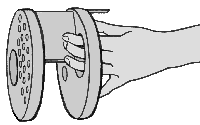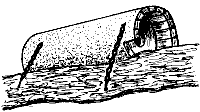Little Owl Box Type "No 20 B" - forced ventilation system - easy to check from entrance side - protected against martens |
|
The little owl, a fascinating, tiny bird! Sadly the 22 cm little owl is one of the species of owl most at risk of extinction. It can be identified by its dark brown upper parts, spotted with white, and its white "eyebrows". Its undulating flight, similar to that of a woodpecker, is a very characteristic feature. Little owls are resident throughout the year and mate for life. |
 [Pic. 1]: Little Owl |
They are not only renowned for their fidelity but also for their attachment to a particular breeding site. Eggs are usually laid from mid-April to mid-May and between 3 and 5 young are raised each year. The diet is very varied and, depending on the season, includes field mice and other small mammals, worms, reptiles and many small insects and invertebrates. Little owls require open ground such as fields with trees and hedges, extensive orchards or parkland that is not too intensively farmed. The destruction of old orchards and the loss of white willows following the consolidation of arable land in the 1970s and 1980s, more intensive agriculture and increased construction of roads and housing, have systematically deprived this species of much of its habitat. To help it to survive we must retain or create habitats. By providing alternative sites the installation of artificial nesting aids is a very quick way of encouraging successful breeding, more so than with almost any other species. Let us make the most of these opportunities. |
|
 [Pic. 2]: Little Owl Box No. 20 B  [Pic. 3]: Protection against Martens [Pic. 4]: Forced Ventilation System  [Pic. 5]: removable entrance section  [Pic. 6]: Example of installation on horizontal branch |
Little Owl Boxes Special nesting facilities for little owls have been used with great success for more than 30 years. What is the ideal number of nesting sites? Population studies show that territories cover only about 0.5 km≤. At least two or three boxes should be provided for each breeding pair because, in addition to the box used for the brood, others are required to store stocks of food and for daytime use. Design improvements This nesting box has been developed on the basis of our other existing Little Owl Boxes which have been very successfully used for many decades. The advantages of the type 20 B are clearly evident: Protection against martens Martens are prevented from entering this box by the two offset entrance holes, an arrangement that hasproved its effectiveness (please see pic. 3). Forced ventilation (please see pic. 4) The unique, forced ventilation system which is built into the end of the box enables stale air to be replaced without causing a draught. This system also ensures that no light can enter the box. The amount of droppings and the resulting moisture, which can otherwise adversely affect the successful survival of the brood, are substantially reduced. Cleaning and inspection (please see pic. 5) The access section can be completely removed, making it easier to clean and inspect the box from the front. Installation (pic 6) On almost all kinds of trees except cherry, because the cherry harvest coincides with the time when the young are still at the nest site. If possible the little owl box should be mounted on a horizontal branch, to which it is attached using the four galvanised, perforated metal strips and our special aluminium nails. The boxes can also be attached in the tops of pollarded trees. The access for the birds should always face the trunk. It is very important to include some short wood shavings as a basis for the nest. Material of the Little Owl Box: Wooden batons mounted on wood-concrete rings, and covered with specially sanded roofing felt. Robust, removable entrance section, made of water-resistant wood laminate. Delivery includes: - Little owl box with forced ventilation - Removable entrance section - Attachment materials Dimensions of Little Owl Box No. 20B External ∆ approx. 23 cm, length 83 cm Weight: approx. 8.3 kg Entrance hole: ∆ 65 mm Little Owl Box No 20B order no. 00 247 / 1 |

